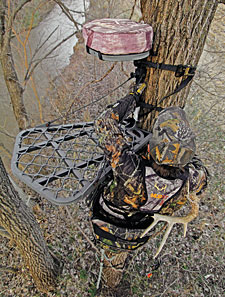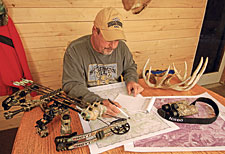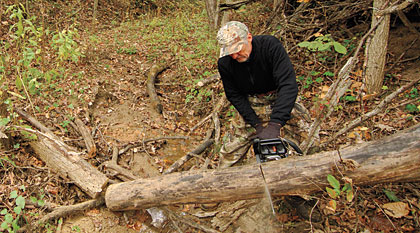October 28, 2010
By Bill Winke
Using Topography To Tag Out...
By Bill Winke
Since I started writing 20 years ago, I've reported on scores of huge bucks taken by bowhunters. The number of hunters who took monster bucks after patterning those deer and then setting up a stand based on that pattern has been very low -- well under 10 percent. Most often, the hunters never even knew the bucks existed until they came slipping past the treestand.
Even more amazing is the number of giant deer that were the hunter's first deer, or first with a bow. It's gotten to the point where I don't even ask, because my heart can't bear the answer. "Yep, I just bought the bow last month," the hunter will often say. "This bowhunting is really great, isn't it?" Umm, yea sure, real great.
Advertisement
Most of the biggest bucks are tagged by chance, not by design. When you set out to arrow one particular deer, you're challenging the master at his own game. That is a game few of us will win; at least not very often. Patterning is the ultimate challenge, but there has to be a way that hunters with limited time can still take mature bucks with some level of consistency. That is what this article is all about.
The Easiest Stand
It's easy to lose faith in a game plan when it starts to sound like a page from a pro football playbook. Deer behavior isn't predictable enough that we can reduce our strategy to a set of steps. Let's face it; there's a lot of luck involved and a lot of stand time. The best we can do is focus on tendencies, play the odds with our stand choices and then put in the time. Simple solutions are easy to understand and trust; they instill confidence. So, I am going to focus on simplifying what can seem like a snarled mess.
Advertisement
Of all the stand locations I've hunted through the years, one setup is by far the easiest to find and hunt. It's a great spot anyone can, and should, hunt effectively. Success revolves around a simple crack in the earth. You can find erosion ditches nearly everywhere, and they influence deer movement in a very predictable way. By focusing on ditches, you can completely change the way you hunt and add a new level of simplicity and clarity to your bowhunting strategy.
 Stands overlooking ditch and creek crossings will quickly become your favorites because they funnel buck movement in a predictable way and they have built-in undetected access routes. |
You can walk into an area you've never seen before and within half a day be hunting some of the best stand sites on the property. Ditches are consistent producers because deer avoid them. Once you know where a deer won't go, you can easily find a funnel nearby. Try to pattern bucks all you want, but when it comes down to actually tagging them, I'll take the terrain, and more specifically ditches, wherever I find them.
Here's a typical ditch layout: The ditch starts at the top of a slope as a dip or low spot in a ridgetop field. It is just enough to channel water runoff. As the dip rolls down the slope, it becomes deeper and narrower; an erosion ditch forms at the bottom. Near the top of the ridge, the ditch is fairly shallow, but as it progresses, it gathers more water and by the time it hits the valley below, it is often a very impressive ravine.
Deer that are moving naturally will avoid crossing a deep ditch because there are usually easier routes nearby. That is how this very predictable funnel is created.
The deeper and steeper the ditch banks, the better it will act as a deterrent to travel and the better the funnel effect will be on either end. Similarly, ditches that have long stretches between crossings are also better, because the deer movement is more concentrated at the places where the deer can cross.
Finding the Best Ditches
You don't even have to know where a deer is going or where it's coming from to hunt ditches effectively. You only need to know there are deer in the area. Given any reason at all to travel (such as the rut or normal feeding patterns), they will use these funnels. This really simplifies the scouting process. You don't need to walk an entire piece of ground to identify potential ditch funnels. All it takes is an aerial photo or topographical map and a few short hikes to check out the ditches that occur in the bottoms of obvious draws.
Topo maps do a better job of revealing ditches than aerial photos because they show the actual contour lines. You'll see a parallel zigzag in the lines in places where draws (valleys or ravines) occur. But, in the absence of a topo map, an aerial photo will show shading depending on the sun angle at the time the photo was taken. The shading reveals the deepest ravines, which usually have ditches at the bottom.
You can find ditches very quickly by walking along the side of hills. Even areas with only moderate changes in elevation can still produce ditches deep enough to funnel deer movement. As little as 50-100 feet can produce a suitable ditch if the soil is free of shallow bedrock.
 Aerial photos and topo maps will help you determine where you are likely to find ditches in new areas and will confirm entry and exit strategies for hunting these locations effectively. |
Setting the Perfect AmbushWalk the length of each ditch in your hunting area. You should find sections where the banks are steep and sections where they're gradual. Focus most of your attention on the ditches that are steepest and deepest. Note the places where deer cross them. Ideally, there won't be very many crossings. Each one is a potential stand site.
Now, you have to decide which crossings to hunt. First, examine the landscape to figure out how the wind will flow. Typically, it will swirl anytime it blows past a protected area or dead pocket of air. For example, when the wind blows over a ravine, it will swirl because the air in the ravine isn't moving as fast as the air above it. Anytime you hunt an area with swirling winds, you are taking a big chance of burning out your hunting area. You may get lucky and tag a nice buck when the wind is just right (I've gotten away with it a few times). But more likely you will get busted by everything in the area because your scent is being washed in every direction.
If you plan to hunt an area more than once, you have to avoid
situations where you can't control your scent. And taking it one step farther, you need to avoid hunting in areas that are protected from the direct flow of the wind. That doesn't leave a lot. For the most part, it leaves only one option (but a very good option) -- the upper end of the ditch.
As you walk up the hill along the ditch, the last good crossing closest to the top will offer the most consistent wind and is the best choice for your stand. You have two wind options here. The wind can either be coming from the ridgetop toward the slope, which will presumably carry your scent airborne over the valley below (local terrain effects don't always allow this to work). The wind can also be coming from the opposite direction -- blowing toward the top of the ridge. On the best crossings, you should set up two stands, one above and one below the crossing so you can hunt the spot on either of these two acceptable winds.
No-Brainer Access
Ditches not only funnel deer movement but make getting to and from your stands simple. You start at the bottom of the valley and just walk right up the ditch. Usually ditches are littered with deadfalls, so you will probably have to go in during the off-season with a chainsaw and clear a path in each of the ditches you hunt.
 Ditches are magnets for deadfalls and logjams. Take a chainsaw and open up the ditches you plan to hunt so you can walk through easily when accessing your stands. |
Using the bottom of the ditch as your entry and exit makes great sense for three reasons: sight, sound and scent. By walking up the ditch you stay out of sight, keep your ground scent in a place where approaching deer won't hit it and you reduce noise. This is the perfect entry and exit scenario.
Timing
Ditch stands can be productive any time of day, but my experience says mornings are best. I think it has to do with buck traffic between bedding areas, which always seems to be higher in the morning. Don't give up too early, though. During the rut, this kind of movement can occur right up to midday and even beyond. However, I've noticed ditch stands are often fairly dead during the later afternoon, as it seems bucks are following does toward feeding areas and are less likely to be traveling from bedding area to bedding area.
This doesn't mean a ditch stand won't produce during the afternoon; it is just a little slower. But, if you don't have any better choices, don't hesitate to hunt the ditch stand in the afternoon too. You're not hunting the whole herd. It only takes one buck to turn your entire season into a successful one, and he can come past at any time.
Look for simple strategies you can count on, such as a single aspect of the terrain that influences deer movement in a predictable way. Find that and everything suddenly seems to snap into focus. No terrain features are easier to find and hunt than erosion ditches. They form bowhunting's simplest strategy.

